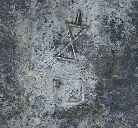Cypro-Minoan signs
All of the Haifa ingots are engraved with two signs. This sign pictured here is found on every one of the Haifa ingots. The writing has been identified as possibly belonging to the Cypro-Minoan script. This script, attested from the 16th century BCE onwards, was used on the island of Cyprus and in the city of Ugarit, on the Syrian coast. Cypro-Minoan has not been deciphered and it is uncertain which language(s) it was used for. .
Due to the island’s rich sources of copper, Cyprus was an important node in the Bronze Age trade network. Evidence for this can be found in the many trade wares found all across the Mediterranean bearing Cypro-Minoan signs. Especially common are the inscriptions consisting of two signs, as on the Haifa ingots.
Want to know more about this script? Then go to the long read.


